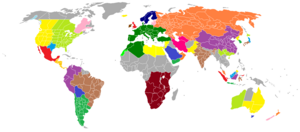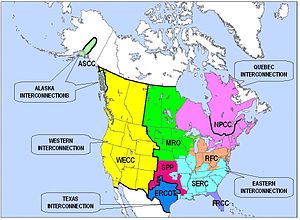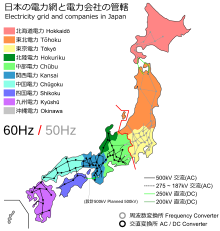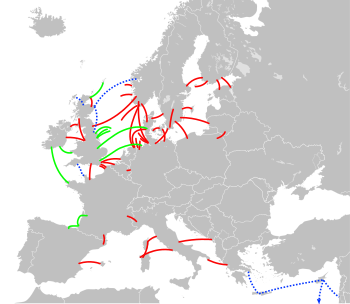Wide area synchronous grid



A wide area synchronous grid (also called an "interconnection" in North America) is a three-phase electric power grid that has regional scale or greater that operates at a synchronized utility frequency and is electrically tied together during normal system conditions. Also known as synchronous zones, the most powerful is the synchronous grid of Continental Europe (ENTSO-E) with 859 gigawatts (GW) of generation, while the widest region served is that of the IPS/UPS system serving most countries of the former Soviet Union. Synchronous grids with ample capacity facilitate electricity trading across wide areas. In the ENTSO-E in 2008, over 350,000 megawatt hours were sold per day on the European Energy Exchange (EEX).[1]
Each of the interconnects in North America are synchronized at a nominal 60 Hz, while those of Europe run at 50 Hz. Neighbouring interconnections with the same frequency and standards can be synchronized and directly connected to form a larger interconnection, or they may share power without synchronization via high-voltage direct current power transmission lines (DC ties), solid-state transformers or variable-frequency transformers (VFTs), which permit a controlled flow of energy while also functionally isolating the independent AC frequencies of each side.
The benefits of synchronous zones include pooling of generation, resulting in lower generation costs; pooling of load, resulting in significant equalizing effects; common provisioning of reserves, resulting in cheaper primary and secondary reserve power costs; opening of the market, resulting in possibility of long term contracts and short term power exchanges; and mutual assistance in the event of disturbances.[2]
One disadvantage of a wide-area synchronous grid is that problems in one part can have repercussions across the whole grid.
Properties[]
Wide area synchronous networks improve reliability and permit the pooling of resources. Also, they can level out the load, which reduces the required generating capacity, allow more environmentally-friendly power to be employed; and allow more diverse power generation schemes and permit economies of scale.[3]

Wide area synchronous networks cannot be formed if the two networks to be linked are running at different frequencies or have significantly different standards. For example, in Japan, for historical reasons, the northern part of the country operates on 50 Hz, but the southern part uses 60 Hz. That makes it impossible to form a single synchronous network, which was problematic when the Fukushima Daiichi plant melted down.
Also, even when the networks have compatible standards, failure modes can be problematic. Phase and current limitations can be reached, which can cause widespread outages. The issues are sometimes solved by adding HVDC links within the network to permit greater control during off-nominal events.
As was discovered in the California electricity crisis, there can be strong incentives among some market traders to create deliberate congestion and poor management of generation capacity on an interconnection network to inflate prices. Increasing transmission capacity and expanding the market by uniting with neighboring synchronous networks make such manipulations more difficult.
Frequency[]
In a synchronous grid all the generators naturally lock together electrically and run at the same frequency, and stay very nearly in phase with each other. For rotating generators, a local governor regulates the driving torque, and helps maintain more or less constant speed as loading changes. Droop speed control ensures that multiple parallel generators share load changes in proportion to their rating. Generation and consumption must be balanced across the entire grid, because energy is consumed as it is produced. Energy is stored in the immediate short term by the rotational kinetic energy of the generators.
Small deviations from the nominal system frequency are very important in regulating individual generators and assessing the equilibrium of the grid as a whole. When the grid is heavily loaded, the frequency slows, and governors adjust their generators so that more power is output (droop speed control). When the grid is lightly loaded the grid frequency runs above the nominal frequency, and this is taken as an indication by Automatic Generation Control systems across the network that generators should reduce their output.
In addition, there's often central control, which can change the parameters of the AGC systems over timescales of a minute or longer to further adjust the regional network flows and the operating frequency of the grid.
Where neighboring grids, operating at different frequencies, need to be interconnected, a frequency converter is required. HVDC Interconnectors, solid-state transformers or variable-frequency transformers links can connect two grids that operate at different frequencies or that are not maintaining synchronism.
Timekeeping[]
For timekeeping purposes, over the course of a day the operating frequency will be varied so as to balance out deviations and to prevent line-operated clocks from gaining or losing significant time by ensuring there are 4.32 million on 50 Hz, and 5.184 million cycles on 60 Hz systems each day.
This can, rarely, lead to problems. In 2018 Kosovo used more power than it generated due to a row with Serbia, leading to the phase in the whole synchronous grid of Continental Europe lagging behind what it should have been. The frequency dropped to 49.996 Hz. Over time, this caused synchronous electric clocks to become six minutes slow until the disagreement was resolved.[4]
DC interconnectors[]

Interconnectors such as High-voltage direct current lines, solid-state transformers or variable-frequency transformers can be used to connect two alternating current interconnection networks which are not necessarily synchronized with each other. This provides the benefit of interconnection without the need to synchronize an even wider area. For example, compare the wide area synchronous grid map of Europe (in the introduction) with the map of HVDC lines (here to the right). Solid state transformers have larger losses than conventional transformers, but DC lines lack reactive impedance and overall HVDC lines have lower losses sending power over long distances within a synchronous grid, or between them.
Deployed networks[]
| Name | Covers | Generation capacity | Yearly generation | Year/Refs |
|---|---|---|---|---|
| Continental Europe | Managed by ENTSO-E. 24 European countries, serving 450 million | 859 GW | 2569 TWh | 2017[5] |
| Eastern Interconnection | Eastern US (except most of Texas) and eastern Canada (except Quebec and Newfoundland and Labrador) | 610 GW | ||
| Indian National Grid | India serving over a billion people | 370.5 GW | 1236 TWh | 2017[6] |
| IPS/UPS | 12 countries of former Soviet Union serving 280 million | 337 GW | 1285 TWh | 2005[7][8] |
| Western Interconnection | Western US, western Canada, and northern Baja California in Mexico | 265 GW | 883 TWh | 2015[9] |
| National Interconnected System (SIN) | Electricity sector in Brazil | 150.33 GW | 410 TWh (2007) | 2016 |
| Synchronous grid of Northern Europe | Nordic countries (Finland, Sweden-except Gotland, Norway and Eastern Denmark) serving 25 million people. | 93 GW | 390 TWh | |
| National Grid (Great Britain) | Great Britain's synchronous zone, serving 65 million. Run by National Grid plc | 83 GW (2018)[10] | 336 TWh | 2017[10] |
| Iran National Grid | Iran and Armenia, serving 84 million people | 82 GW | 2019[11] | |
| Texas Interconnection | Most of Texas; the Electric Reliability Council of Texas serves (ERCOT) serves 24 million customers | 78 GW | 352 TWh (2016)[12] | 2018[13] |
| National Electricity Market | Australia's States and Territories except Western Australia and the Northern Territory. (Tasmania is part of it but not synchronised) | 50 GW | 196 TWh | 2018[14] |
| Quebec Interconnection | Quebec | 42 GW | 184 TWh | |
| Java-Madura-Bali Interconnection (JAMALI) | JAMALI System serves 7 provinces (West, East, and Central Java, Banten, Jakarta, Yogyakarta, and Bali). Run by PLN, serving 49.4 million customers. | 40.1 GW (2020)[15] | 163 TWh (2017)[16] | 2021 |
| Argentine Interconnection System | Argentina except Tierra del Fuego. | 129 TWh | 2019[17] | |
| SIEPAC | The Central American Electrical Interconnection System serves Costa Rica, El Salvador, Guatemala, Honduras, Nicaragua and Panama. | |||
| SWMB | South Western Mediterranean Block serves Morocco, Algeria and Tunisia. | |||
| Southern African Power Pool | SAPP serves 12 countries in Southern Africa. | |||
| Irish Grid | Ireland. Run by EirGrid | 29.6 TWh | (2020) [18] | |
| State Grid | Northern Chinese State Grid run by State Grid Corporation of China | |||
| China Southern Power Grid | Chinese southern grid. Run by China Southern Power Grid | |||
| South West Interconnected System | Western Australia | 17.3 TWh | 2016[19] | |
| Sistema Interconectado Central | Main Chilean grid | 12.9 GW | 2011[20] |
A partial table of some of the larger interconnections.
Planned[]
- China's electricity suppliers plan to complete by 2020 its ultra high voltage AC synchronous grid linking the current North, Central, and Eastern grids.[21] When complete, its generation capacity will dwarf that of the UCTE Interconnection.
- Union of the UCTE and IPS/UPS grid unifying 36 countries across 13 time zones.[22]
- Unified Smart Grid unification of the US interconnections into a single grid with smart grid features.
- SuperSmart Grid a similar mega grid proposal linking UCTE, IPS/UPS, North Africa and Turkish networks.
Planned non-synchronous connections[]
The Tres Amigas SuperStation aims to enable energy transfers and trading between the Eastern Interconnection and Western Interconnection using 30GW HVDC Interconnectors.
See also[]
- High-voltage direct current (HVDC)
- Super grid
- European super grid
- Microgrid
- Smart grid
- Unified Smart Grid
- SuperSmart Grid
- Tres Amigas SuperStation
References[]
- ^ "EEX Market Monitor Q3/2008" (PDF). Leipzig: Market Surveillance (HÜSt) group of the European Energy Exchange. 2008-10-30: 4. Retrieved 2008-12-06. Cite journal requires
|journal=(help) - ^ Haubrich, Hans-Jürgen; Dieter Denzel (2008-10-23). "Characteristics of interconnected operation" (PDF). Operation of Interconnected Power Systems (PDF). Aachen: Institute for Electrical Equipment and Power Plants (IAEW) at RWTH Aachen University. p. 3. Retrieved 2008-12-06. (See "Operation of Power Systems" link for title page and table of contents.)
- ^ https://www.un.org/esa/sustdev/publications/energy/chapter2.pdf
- ^ "Serbia, Kosovo power grid row delays European clocks". Reuters. Mar 7, 2018.
- ^ "ENTSO-E Statistical Factsheet 2017" (PDF). www.entsoe.eu. Retrieved 2 January 2019.
- ^ Electricity sector in India
- ^ UCTE-IPSUPS Study Group (2008-12-07). "Feasibility Study: Synchronous Interconnection of the IPS/UPS with the UCTE". TEN-Energy programme of the European Commission: 2. Cite journal requires
|journal=(help) - ^ Sergei Lebed RAO UES (2005-04-20). "IPS/UPS Overview" (PDF). Brussels: UCTE-IPSUPS Study presentation: 4. Retrieved 2008-12-07. Cite journal requires
|journal=(help) - ^ 2016 State of the Interconnection page 10-14 + 18-23. WECC, 2016. Archive
- ^ Jump up to: a b https://www.gov.uk/government/statistics/electricity-chapter-5-digest-of-united-kingdom-energy-statistics-dukes
- ^ "Dalahoo Power Plant Adds 310 MW to Power Capacity". Eghtesad Online. Retrieved 2019-12-02.
- ^ http://www.ercot.com/content/wcm/lists/89476/ERCOT2016D_E.xlsx
- ^ "Quick facts" (PDF). www.ercot.com. 818.
- ^ https://www.aer.gov.au/wholesale-markets/wholesale-statistics/electricity-supply-to-regions-of-the-national-electricity-market
- ^ Mediatama, Grahanusa (2021-02-23). "PLN: Ada tambahan 3.000 MW pembangkit listrik di sistem Jawa-Madura-Bali tahun ini". kontan.co.id (in Indonesian). Retrieved 2021-04-24.
- ^ synergy (2017-04-28). "Indonesia's Electricity Systems - Jawa-Madura-Bali System". Insights. Retrieved 2021-04-24.
- ^ "Informe anual 2019" [2019 Annual report]. portalweb.cammesa.com (in Spanish). Compañía Administradora del Mercado Mayorista Eléctrico Sociedad Anónima. 12 June 2020. Retrieved 2020-08-10.
- ^ "Wind Energy Powers Ireland to Renewable Energy Target". 28 Jan 2021.
- ^ https://westernpower.com.au/media/2308/facts-and-statistics-2015-16.pdf
- ^ SIC installed capacity. Central Energía. Retrieved: 15-05-2012
- ^ Liu Zhengya President of SGCC (2006-11-29). "Address at the 2006 International Conference of UHV Transmission Technology". Beijing: UCTE-IPSUPS Study presentation. Retrieved 20068-12-06. Cite journal requires
|journal=(help); Check date values in:|access-date=(help) - ^ Sergey Kouzmin UES of Russia (2006-04-05). "Synchronous Interconnection of IPS/UPS with UCTE - Study Overview" (PDF). Bucharest, Romania: Black Sea Energy Conference: 2. Retrieved 2008-12-07. Cite journal requires
|journal=(help)
External links[]
- Wide area synchronous grids
- Electric power transmission systems